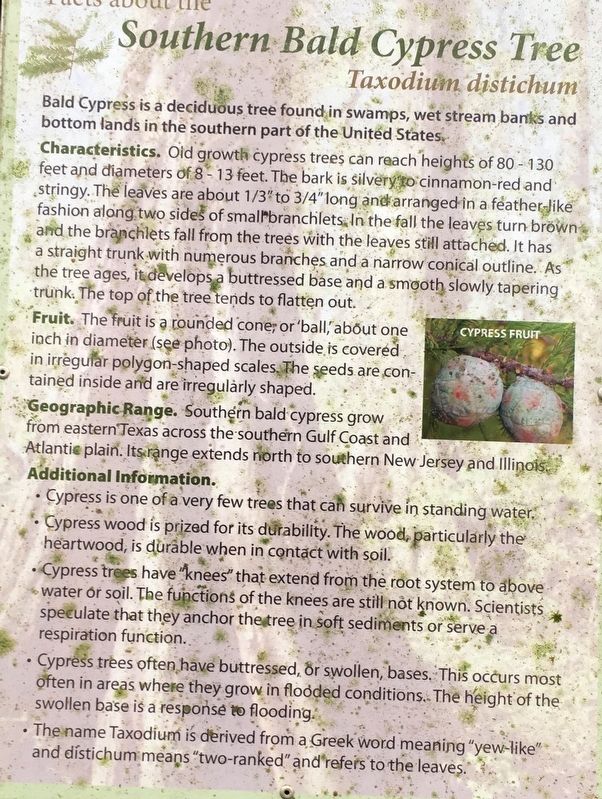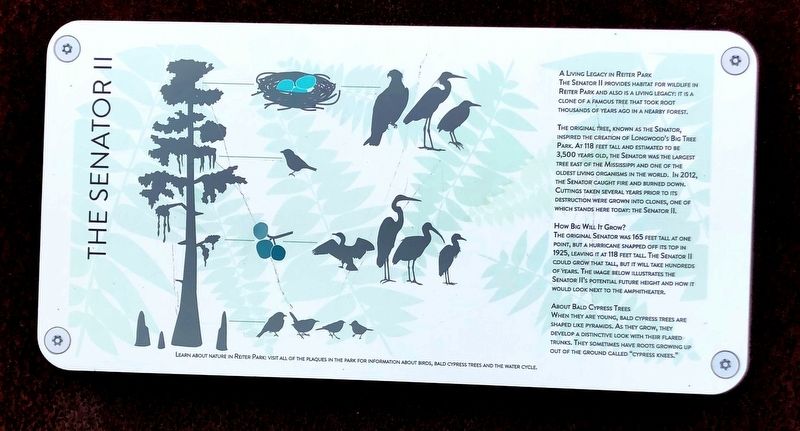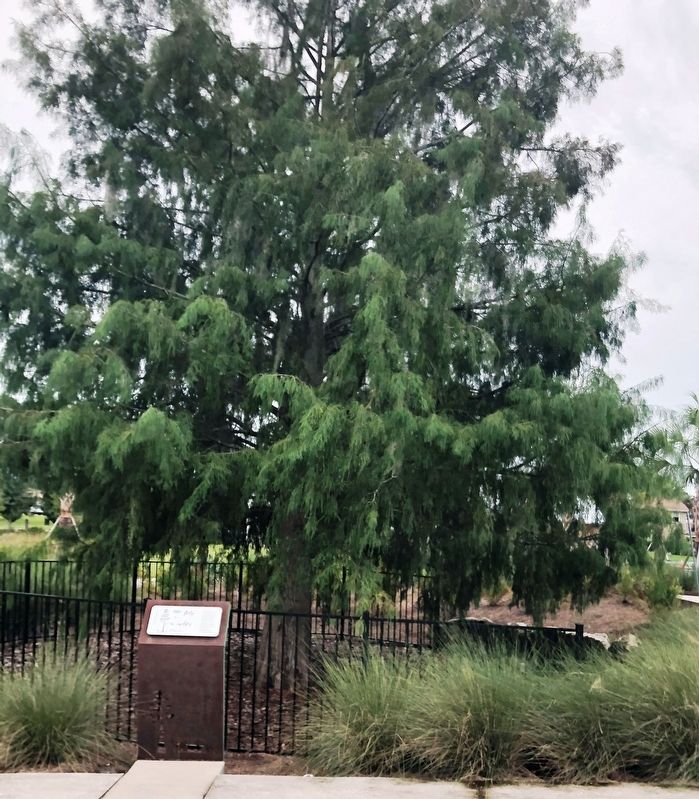Longwood in Seminole County, Florida — The American South (South Atlantic)
The Senator II
A Living Legacy in Reiter Park
The Senator II provides habitat for wildlife in Reiter Park and is a living legacy: it is a clone of a famous tree that took root thousands of years ago in a nearby forest.
The original tree, known as the Senator, inspired the creation of Longwood’s Big Tree park. At 118 feet tall and estimated to be 3,500 years old, the Senator was the largest tree east of the Mississippi and one of the oldest living organisms in the world. In 2012, the Senator caught fire and burned down. Cuttings taken several years prior to its destruction were grown into clones, one of which stands here today: the Senator II.
How Big Will It Grow?
The original Senator was 165 feet tall at one point, but a hurricane snapped its top in 1925, leaving it at 118 feet tall. The Senator II could grow that tall, but it will take hundreds of years. The image below illustrates the Senator II's potential future height and how it would look next to the amphitheater.
About Bald Cypress Trees
When they are young, bald cypress trees are shaped like pyramids. As they grow, they develop a distinctive look with their flared trunks. They sometimes have roots growing up out of the ground called “cypress knees.”
Topics. This historical marker is listed in this topic list: Horticulture & Forestry . A significant historical year for this entry is 2012.
Location. 28° 42.062′ N, 81° 21.062′ W. Marker is in Longwood, Florida, in Seminole County. Marker can be reached from the intersection of West Warren Avenue and North Milwee Street. Marker located within Reiter Park. Touch for map. Marker is at or near this postal address: 311 W Warren Ave, Longwood FL 32750, United States of America. Touch for directions.
Other nearby markers. At least 8 other markers are within 2 miles of this marker, measured as the crow flies. Heroes Monument (within shouting distance of this marker); Historic Longwood/E.W. Henck (approx. 0.2 miles away); Longwood Hotel/Bradley McIntyre House (approx. ¼ mile away); Lady Liberty (approx. 1.7 miles away); Big Tree (approx. 1.7 miles away); "The Phoenix"… (approx. 1.8 miles away); John & Annie Griffin (approx. 1.9 miles away); Concord Cemetery (approx. 1.9 miles away). Touch for a list and map of all markers in Longwood.

Photographed By Brandon D Cross, September 13, 2020
3. Southern Bald Cypress Tree Descriptive Panel
Bald Cypress is a deciduous tree found in swamps, wet stream banks and
bottom lands in the southern part of the United States.
Characteristics. Old growth cypress trees can reach heights of 80–130 feet and diameters of 8-13. The bark is silvery to cinnamon-red and Stringy. The leaves are about 1/3” to ¾” long and arranged in a feather-like fashion along two sides of small branchlets. In the fall the leaves turn brown and the branchlets fall from the trees with the leaves still attached. It has a straight trunk with numerous branches and a narrow conical outline. As the tree ages, it develops a buttressed base and a smooth slowly tapering trunk. The top of the tree tends to flatten out.
Fruit. The fruit is a rounded cone or ‘ball’ about one inch in diameter (see photo). The outside is covered in irregular polygon-shaped scales. The seeds are contained inside and are irregularly shaped.
Geographic Range. Southern bald cypress grow from eastern Texas across the southern Gulf Coast and Atlantic plain. Its range extends north to southern New Jersey and Illinois.
Additional Information.
• Cypress is one of a very few trees that can survive in standing water.
• Cypress wood is prized for its durability. The wood, particularly the heartwood, is durable when in contact with soil.
• Cypress trees have “knees” that extend from the root system to above water or soil. The functions of the knees are still not known. Scientists speculate that they anchor the tree in soft sediments or serve a respiration function.
• Cypress trees often have buttressed, or swollen, bases. This occurs most often in areas where they grow in flooded conditions. The height of the swollen base is a response to flooding.
• The name Taxodium is derived from a Greek word meaning “yew-like” and distichum means “two-ranked” and refers to the leaves.
Characteristics. Old growth cypress trees can reach heights of 80–130 feet and diameters of 8-13. The bark is silvery to cinnamon-red and Stringy. The leaves are about 1/3” to ¾” long and arranged in a feather-like fashion along two sides of small branchlets. In the fall the leaves turn brown and the branchlets fall from the trees with the leaves still attached. It has a straight trunk with numerous branches and a narrow conical outline. As the tree ages, it develops a buttressed base and a smooth slowly tapering trunk. The top of the tree tends to flatten out.
Fruit. The fruit is a rounded cone or ‘ball’ about one inch in diameter (see photo). The outside is covered in irregular polygon-shaped scales. The seeds are contained inside and are irregularly shaped.
Geographic Range. Southern bald cypress grow from eastern Texas across the southern Gulf Coast and Atlantic plain. Its range extends north to southern New Jersey and Illinois.
Additional Information.
• Cypress is one of a very few trees that can survive in standing water.
• Cypress wood is prized for its durability. The wood, particularly the heartwood, is durable when in contact with soil.
• Cypress trees have “knees” that extend from the root system to above water or soil. The functions of the knees are still not known. Scientists speculate that they anchor the tree in soft sediments or serve a respiration function.
• Cypress trees often have buttressed, or swollen, bases. This occurs most often in areas where they grow in flooded conditions. The height of the swollen base is a response to flooding.
• The name Taxodium is derived from a Greek word meaning “yew-like” and distichum means “two-ranked” and refers to the leaves.
Credits. This page was last revised on September 25, 2020. It was originally submitted on September 24, 2020, by Brandon D Cross of Flagler Beach, Florida. This page has been viewed 209 times since then and 23 times this year. Photos: 1, 2, 3. submitted on September 24, 2020, by Brandon D Cross of Flagler Beach, Florida. • Bernard Fisher was the editor who published this page.

